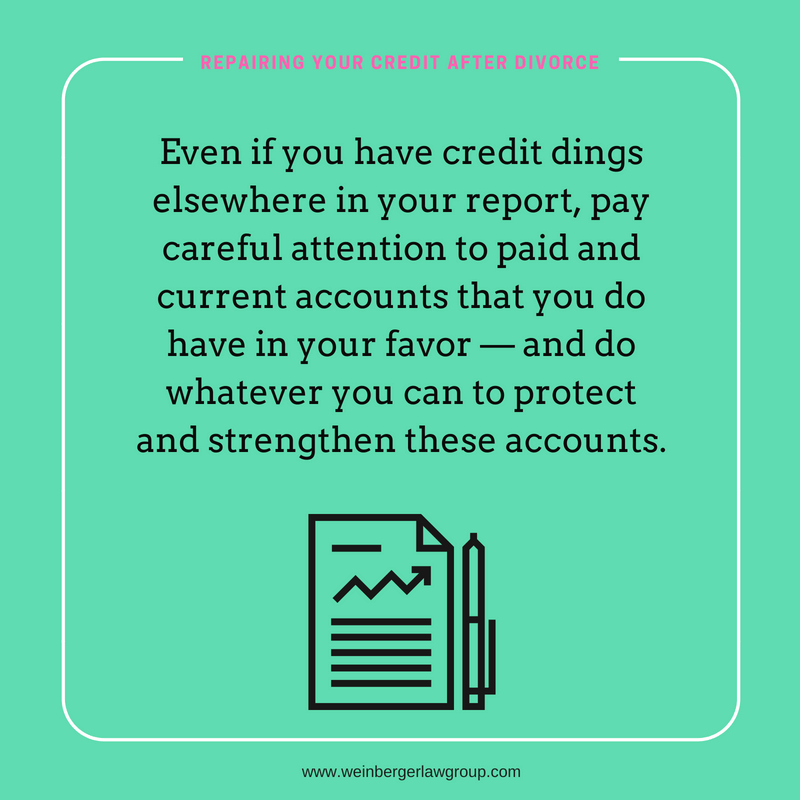7 Steps for Repairing Your Credit After Divorce

Does part of preparing for your new post-divorce life require repairing or rebuilding your credit history?
Rehabbing a credit score is something that requires multiple smaller steps, and time — like most large tasks. But here’s some good news: while it’s often true that the path to good credit takes diligent effort, gaining traction is often not as difficult as it first appears.
You can get started right now by learning 7 steps to basic divorce credit repair.
Step 1: Check your credit report
Carefully looking over your credit report gives you a benchmark of where you are right now is important for many different reasons. Have you ever seen a credit report before? Do you recognize all the items listed on your report? Which accounts are joint accounts? Is there anything that seems unusual? You can obtain a free credit report annually at freecreditreport.com or you can obtain it from any of the major reporters: Experian, Trans Union and Equifax. Major credit bureaus also offer guides for how to read these reports.
Step 2: Close all joint credit cards
Once you’ve made the decision to divorce, go through your accounts and close all joint credit cards. This won’t erase the debt, but it will stop any new debt from being accrued. This is an important step even if you are good terms with your soon-to-be ex.
Important note: Cutting a credit card in half may prevent you from physically using it, but this is not the same as closing the account. To official terminate the line of credit associated with the card, you will need to contact the credit card company directly and may need to co-sign any documents associated with closing the account. If your spouse volunteers to be in charge of submitting paperwork, insist on receiving documentation from the creditor stating the closure of the account.
Step 3: Use your divorce as a credit repair tool
Your initial thoughts about your divorce may so heavily focused on what will become of your marital assets — your home equity, your retirement, your savings — that you don’t think about the implications of your marital debts, including balances on mortgages, credit card debts, car loan debts and car lease agreements, and other debts in both your names.
Divorce can be an important tool to address these debts and protect your credit now and in the future. For example, if you will sell your home and divide the equity after the mortgage is paid off, you and your spouse can consider taking a portion of the pre-divided equity and applying it to wiping out or significantly paying down all joint credit cards (and other joint debts). Walking away from your marriage with little to no marital debt and a chunk (albeit a smaller chunk) to put towards a new affordable home can give you strong financial footing. Every situation is different, so carefully discuss your options with your attorney.
Step 4: Beware joint card payments
If you do address your debts as part of your formal divorce settlement, a big bonus is that doing so will create a written agreement. This may become extremely important down the road. Let’s say the two of you owe $25K spread out fairly evenly over two joint credit cards. In your divorce settlement there is language that you each agree to pay off one of the cards within 3 years. You’ve been keeping up your end of the bargain, but you eventually find out — usually by a call from a collections agency — that your spouse has not.
With your settlement in hand, you can go to the courts for payment enforcement. With no written agreement, the courts may not be able to help you and you could find yourself needing to decide between paying it yourself or taking a hit on your credit. To disentangle yourself completely from this kind of mess, see Step 3 and really think carefully about how to wipe out as much debt as possible through smart use of assets.
Step 5: Apply for solo credit card in your name only
Having a credit card can be useful in an emergency and your ability to use and pay your credit on time is part of building a good credit history and good credit score. You don’t need to be divorced to have a credit card that is in your name only.
To obtain your first solo card, think carefully about your options. If you have poor credit, a main way to obtain a credit card may be to obtain a secured credit card where you deposit with the creditor the amount that will be allowed on the card. These cards may have a higher APR and/or annual fee, but it is a place to start. Use the card faithfully and pay off your statement in full each month. This will help increase your credit worthiness and give you more options for obtaining a card with better rates.
Another option is to go to your own bank and ask about any credit cards they offer. Your history with the bank could help you get through any credit hoops and secure a good rate.
Step 6: Protect the good credit you do have
Even if you have credit dings elsewhere in your report, pay careful attention to paid and current accounts that you do have in your favor — and do whatever you can to protect and strengthen these accounts. If there is a credit card that is in your name only and has never been late, put it on an auto-pay so that it continues to never be late and try to put some extra money towards it to pay down (or pay off) the principal.
Credit agencies tend to favor balances under 30% of the card’s limit. So if you have a card that has a $1000 limit and your current balance is close to that amount, try to pay down the card until it’s no more than $300 at any time. You may be rewarded with a credit boost of several points for doing so! Paying your card off completely every month can also score you extra points.
Step 7: Change your name on your accounts if needed
If you changed your surname upon marriage to that of your spouse’s, be aware that changing your last name back after your divorce will not wipe away old credit items. Credit information is tracked via social security number.
However, it is to your advantage to go back to your old accounts and update with your new name as it is easier for communication purposes. It’s also a way to let your creditors know about your situation. In many instances, companies may willing to negotiate with you as a result of your hardship. Ask about lower rates, lower monthly payments or a forgiveness of some of your debt (hey, it can’t hurt!)
And here’s a bonus tip: Protect your ability to pay your bills — both old and new — by creating a budget and sticking to it. If budgeting is new to you, read a personal finance book like Dave Ramsey’s Total Money Makeover and/or any Suze Orman book, or make an appointment with a financial advisor.
As Suze Orman says, “Money is such an amazing teacher: What you choose to do with your money shows whether you are truly powerful or powerless.”
When it comes to making money-smart decisions about repairing your credit, choose to be powerful and you will be powerful enough to start raising that score!
Read more:
Repairing Your Credit After Divorce
Six Crucial Financial Steps to Take Before You File For Divorce
8 Savvy Ways to Prepare for Divorce
Have questions about your divorce? Call us at 888-888-0919 to schedule your initial consultation with one of our experienced and dedicated family law attorneys. Start safeguarding your future today.
Schedule an Initial Consultation


